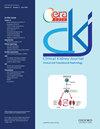Cerebral white matter damage in patients with end stage kidney disease associates with cognitive impairment
IF 3.9
2区 医学
Q1 UROLOGY & NEPHROLOGY
引用次数: 0
Abstract
Background and hypothesis Damages in brain white matter often occurs in individuals with chronic kidney disease, which might be related to their cognitive decline. This study aims to investigate tract specific white matter damage in patients with end stage renal disease by using fixel based analysis. Methods Images of 31 end stage renal disease patients and 16 normal controls (aged: 61.1 ± 10.4 years; 11 men) were acquired from a 1.5 T MR scanner. The patients were subsequently divided into with normal cognition (N = 17, aged: 66.9 ± 7.2 years; 10 men) and cognitive impairment (N = 14, aged: 72.4 ± 9.4 years; 7 men). Cognitive assessment, neurologic, hematologic and biochemical samples were collected. Fixel-based analysis was used to examine the tract-specific damage within white matter. Differences between groups were evaluated through connectivity-based fixel enhancement and non-parametric permutation testing. Correlation with biomarkers was conducted through general linear model. Significance was determined with familywise error-corrected p-value < 0.05. Results Reduced fixel-based metrics were observed in specific tract located the cerebral peduncle, internal capsule, corpus callosum, fornix, and superior corona radiata in patients when compared to normal controls, indicating a reduction in fiber content. The fibers crossing the corpus callosum and the fornix/stria terminalis are particularly vulnerable sites, which can be associated with the decrease in both Mini-Mental State Examination (R2 ranged between 0.420 and 0.556) and Montreal Cognitive Assessment (R2 ranged between 0.425 and 0.509), as well as the plasma concentration of calcium (R2 ranged between 0.207 and 0.322). The plasma concentration of indoxyl sulfate was associated with the descending tracts from right posterior limb of internal capsule to cerebral peduncle (R2 ranged between 0.262 and 0.335). Conclusions Tract specific white matter damage can be noticed in the patients with end stage renal disease, and can be associated with their cognitive decline.终末期肾病患者的脑白质损伤与认知障碍有关
背景与假设 慢性肾脏病患者的脑白质经常受损,这可能与他们的认知能力下降有关。本研究的目的是利用基于固定成像的分析方法研究终末期肾病患者脑白质的特定损伤。方法 通过 1.5 T MR 扫描仪获取 31 名终末期肾病患者和 16 名正常对照组(年龄:61.1 ± 10.4 岁;男性 11 人)的图像。患者随后被分为认知正常(N = 17,年龄:66.9 ± 7.2 岁;男性 10 人)和认知障碍(N = 14,年龄:72.4 ± 9.4 岁;男性 7 人)。收集了认知评估、神经学、血液学和生化样本。采用基于 Fixel 的分析方法来检查白质中的特定损伤。组间差异通过基于连接的定格增强和非参数置换测试进行评估。通过一般线性模型与生物标志物进行相关性分析。显著性以经家系误差校正的 p 值 < 0.05 来确定。结果 与正常对照组相比,在患者位于大脑脚、内囊、胼胝体、穹窿和放射冠上的特定束中观察到基于定值的指标降低,表明纤维含量减少。穿过胼胝体和穹窿/末端结节的纤维是特别脆弱的部位,这可能与迷你精神状态检查(R2 介于 0.420 和 0.556 之间)和蒙特利尔认知评估(R2 介于 0.425 和 0.509 之间)以及血浆钙浓度(R2 介于 0.207 和 0.322 之间)的下降有关。血浆中硫酸吲哚啶的浓度与内囊右后肢到大脑脚的降序相关(R2 介于 0.262 和 0.335 之间)。结论 在终末期肾病患者中可以发现特定的白质损伤,并与他们的认知能力下降有关。
本文章由计算机程序翻译,如有差异,请以英文原文为准。
求助全文
约1分钟内获得全文
求助全文
来源期刊

Clinical Kidney Journal
Medicine-Transplantation
CiteScore
6.70
自引率
10.90%
发文量
242
审稿时长
8 weeks
期刊介绍:
About the Journal
Clinical Kidney Journal: Clinical and Translational Nephrology (ckj), an official journal of the ERA-EDTA (European Renal Association-European Dialysis and Transplant Association), is a fully open access, online only journal publishing bimonthly. The journal is an essential educational and training resource integrating clinical, translational and educational research into clinical practice. ckj aims to contribute to a translational research culture among nephrologists and kidney pathologists that helps close the gap between basic researchers and practicing clinicians and promote sorely needed innovation in the Nephrology field. All research articles in this journal have undergone peer review.
 求助内容:
求助内容: 应助结果提醒方式:
应助结果提醒方式:


